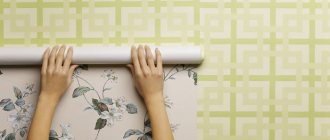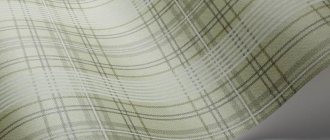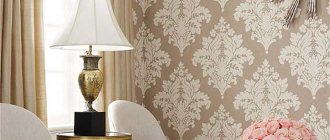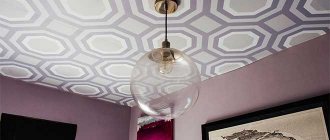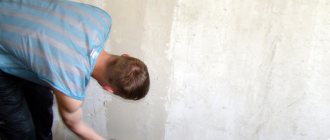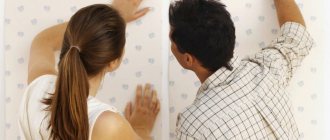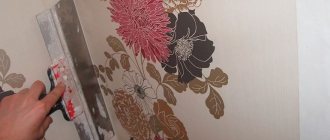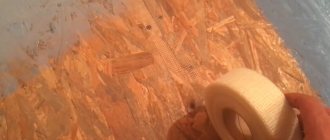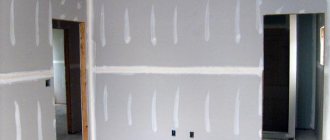Renovating an old apartment can cause some difficulties. The walls of almost all old houses are whitewashed with lime. This is explained by the fact that at the end of the 20th century this finishing method was the most popular due to its low cost and ease of execution.
However, today you can also find walls with lime, so before gluing, you need to know some of the nuances and rules of the feature in order to avoid difficulties and not waste a lot of time.
Is it possible to glue wallpaper over whitewash?
Builders and renovators usually recommend removing whitewash before finishing. Chalk and lime attract moisture from the air, and the wallpaper begins to deteriorate, and at high humidity, it even rots. In order for the wallpaper to stick well, the wall must be prepared in 3 stages:
- Removing whitewash. Usually washed off, so the walls become wet, which leads to the next step.
- Drying the walls. It is allowed to use heat guns and other heating devices to speed up drying. But after this you will have to wait until the wall cools down to room temperature.
- Applying primer. Usually they buy deep penetration mixtures.
But gluing on whitewash is also acceptable. Maximum adhesion cannot be achieved, but lightweight wallpaper adheres well to a wall whitewashed with lime or chalk. If the old coating is firmly attached to the wall, you can leave it.
Will wallpaper stick to whitewashed walls or ceilings?
If you stick them directly onto whitewash without priming them first, they won’t stick well. Usually the coating begins to peel off within the first year of operation. The reason is that lime does not create a good bond with the glue. High-quality products from European brands stick to whitewash better than the cheapest glue, but still very weakly.
A primer applied directly to the whitewash changes the situation radically. The wallpaper holds up well, as is the case when the primer is applied to the putty. But it is better to do 2 primer layers - the second only after the first has dried.
An important clarification: it is always better to remove whitewash from the ceiling. Wallpaper there holds much worse, so complete preparation of the walls by removing the previous coating (any) is very important.
Do I need to wash off the whitewash before wallpapering?
Removing limescale depends greatly on the type of wallpaper. The general rule is that with light wallpaper you don’t have to wash it off, but with heavy wallpaper you will have to wash it off, because it has a weaker grip and runs the risk of falling off.
| Type | Removing whitewash |
| Paper | Not required if it is chalky. Limestone - must be washed off. |
| Lightweight (non-woven and vinyl without embossing or decoration) | Recommended, but not strictly. Such wallpapers are not much heavier than paper ones, and purchasing high-quality glue along with a two-layer primer eliminates the disadvantages of whitewashing. |
| Heavy (non-woven, vinyl, textile, cork, especially with decorative elements) | Required. They adhere poorly to whitewash even with a “layer” of primer and expensive glue. |
| Liquid | Required. Liquid wallpaper requires careful preparation of the walls according to the instructions, and this preparation includes the complete removal of all previous coatings. |
The strength of fixation of the whitewash layer is also important:
- the coating is cracked, crumbles and breaks easily - it is better to wash it off;
- a complete coating that is in good condition can be left at your personal discretion;
- There is no point in touching whitewash that is “tightly” stuck to the walls.
Also, it’s better to wash off the whitewash in old “grandmother’s” houses. In the past, too much lime was often added to the coating. In such proportions, the aggressive substance can “corrode” the wallpaper from the inside.
Causes of the problem
When starting renovations in their own apartment, everyone feels like a real builder and designer rolled into one. But whether your construction talents meet the requirements for repairs and decoration is already a question. Moreover, it is very important, because when you take on a huge scope of work, you may simply not take into account the fact that you may not have enough knowledge and skills to complete them. Although in the era of modern technology, the Internet and special construction literature can provide answers to any questions that concern a novice repairman.
Before you start working, you need to stock up on everything you need
The main thing is to ask in time so as not to do anything stupid and spoil the materials. Moreover, you need to consult even on such seemingly simple questions as: is it possible to glue wallpaper over whitewash and what is the best way to do it? This issue is very relevant in the post-Soviet space, since when buying housing on the secondary real estate market, we often encounter whitewashed walls. In the times of our parents and grandmothers, whitewash was very widely used to cover walls due to the low cost and ease of application of this material. But today there are more beautiful and interesting options for wall decoration, for example, the same wallpaper. Wallpapering is a rather complicated process, but you can do it yourself if you first take into account the surface features, select the glue and wallpaper fabric and read the basic recommendations or watch a video about pasting on the Internet. If we talk about starting a robot, then you definitely need to inspect the walls. It is believed that wallpaper should be glued to an ideally prepared surface, finished with plaster and impregnated with a primer, but what to do in cases where there is an old coating on the walls, for example, whitewash? We will tell you below whether it is possible to paste wallpaper over whitewash and how to do it correctly.
What tools are needed?
The list of tools and consumables may vary slightly depending on the type of coating, room size and repair technology.
The general set is always the same:
- the wallpaper itself;
- wallpaper glue (suitable for the material);
- a roller and a brush to apply glue (it’s better to take both tools - in general, a roller is more convenient, but it’s too bulky for high-quality coating of corners);
- a container for diluting glue (the most convenient is a paint tray with a ribbed part);
- scissors;
- roulette;
- a plumb line (it makes it easier to determine whether the wallpaper is glued evenly);
- spatula (needed to remove flaking fragments of the old coating);
- sandpaper (and an sandpaper holder - it’s more convenient with it);
- soft cloth for smoothing wallpaper on the wall (preferably cotton);
- PVA glue;
- sponge and detergent to quickly wash away accidental glue splashes;
- personal protective equipment (respirator or bandage, glasses are required - there is a lot of dust from whitewashing).
Which wallpaper to choose
| Type of whitewash | Types of Wallpaper |
| With lime | It’s better to take non-woven ones, but vinyl ones (especially embossed ones) are also suitable. Lime strongly interacts with cellulose in any form and spoils it, so it is not advisable to glue paper ones. Fabric ones are also not suitable. |
| Without lime (pure chalky) | Non-woven, paper, vinyl and even fabric are suitable. But when the durability of the repair is a priority, the choice should be given to non-woven and paper ones. |
A separate condition is that the wallpaper should be light. The more the material weighs, the worse it will adhere to any whitewash.
Base analysis
It will not be possible to determine by eye what type of whitewash is involved in the treatment of the wall. And this is important, since not every white substance is suitable for directly holding wallpaper.
There are two simple ways to set the type of whitening:
- Run your palm along the wall - chalk, from which it is better to clean the surface, will stain your palm;
- For all the patterns described above, glue only a small fragment of the rolled product (a perimeter of 20 by 20 centimeters is enough). After waiting for it to dry completely, it is necessary to remove the material - if this was not difficult, it means that the coating is not suitable for holding wallpaper.
Which glue to choose
There are only 2 conditions when choosing glue:
- must match the type and material of the wallpaper;
- It should not be too liquid - the lime may become soggy.
But with proper priming (more on that later), liquid glue will not do any harm. It will not “break through” the primer if it is completely dry after application.
It is better to buy glue from well-known brands (Russian and foreign), having first studied reviews on the Internet. The more popular the brand, the higher the likelihood that someone has already talked about their experience of using it in combination with whitewash.
Will a primer help?
From a philosophical position, there is no resource or tool that guarantees maximum efficiency and usefulness for obtaining a construction result. But this is not a reason to refuse to use any materials, including primer - there is an opinion that it penetrates too deeply into the pores of the whitewash, which is why the effectiveness of the liquid is reduced to zero.
In fact, lime mortar has water-repellent characteristics and a dense consistency, so it is impossible for the soil substance to advance to the inner layers. After priming, you may get the impression that the wall covering has only become stronger, because the surface will no longer stain your fingers. It's all about the resulting film, designed to improve the adhesion of the wall and wallpaper. Therefore, this procedure cannot be neglected.
How to prepare walls for wallpapering
As mentioned earlier, at the beginning of gluing with lime, you need to prime the surface. But that's not all. Full preparation includes:
- removing all crumbling, flaking areas of whitewash (it is convenient to use a metal spatula);
- leveling the walls (after the previous stage, dents will remain - they are filled with putty, and the edges are rubbed with fine-grained sandpaper);
- applying primer to whitewash.
The primer mixture is usually applied in 2 layers. The bottom layer holds the old lime together, and the top layer provides a strong “grip” of the selected glue.
How to prime walls
When gluing over whitewash, an acrylic-based primer is usually used. Its advantages:
- binds lime particles - the previous coating becomes stronger and does not crumble under the influence of wet primer and glue;
- repels moisture;
- It is applied evenly and conveniently with a paint roller.
When the second layer of acrylic primer is completely dry, a layer of adhesive solution is often applied on top. This increases soil stability. To prepare the solution, add PVA to slightly warm water (1 liter of glue per 8-10 liters of water) and mix well with a mixer.
Many people prime whitewashed walls only with PVA solution, without buying acrylic mixtures. This is a good method - sometimes less durable, but not inferior in quality of gluing. It’s better to also do 2 main layers and a finishing coat.
How to stick wallpaper on whitewashed walls
To apply wallpaper to whitewashed walls, you should proceed in this order:
- Remove all furniture and objects that can be removed from the room. Everything else is covered with plastic film, like the floor.
- Completely remove 10 cm of whitewash under the ceiling and above the floor so that the edges of the coating adhere better. After the work, the walls became noticeably uneven; the indentations were filled with putty.
- Apply a layer of deep penetration primer to the whitewash. When dry, apply a second layer (optional, but greatly improves adhesion). Wait for it to dry completely.
- Prepare the glue. While it is “infusing”, the wallpaper is cut into strips according to the height of the walls.
- Use glue. If the wallpaper is paper, coat the back side of the sheet and leave for 3-5 minutes before gluing it to the wall. When the coating is made of a different material, both the wallpaper and the wall itself are smeared with glue.
- Place wallpaper sheets in the direction away from windows and doors. This way you can achieve perfect evenness, and the seams will be less noticeable.
Important - to improve adhesion, areas under the ceiling and corners of the room are often additionally coated with glue. Wallpaper and simple PVA are suitable. And it is better to carry out all work with glue at a temperature of at least 20 ° C, with the windows closed.
What are the advantages and disadvantages of the solution
The banal advantages of the disassembled approach are in saving time, effort and money on construction procedures. In addition, refusing to remove the lime coating helps to avoid an excessively dusty environment in the room, the cleaning of which will also take a long period.
The negative side of the issue lies in water-based paint: it has the property of absorbing water, which reduces the performance of the glue and, as a result, has a bad effect on the reliability of the canvas. Moreover, such a coating is not characterized by vapor permeability, which is why there is a risk of fungi and mold.
What to do if the whitewash is crumbling
It is better to completely remove whitewash that has begun to crumble before using the wallpaper. After all, upon contact with something wet (primer or glue), it will begin to fall off in large layers.
The easiest way to remove whitewash:
- Carefully cover the floor and furniture with oilcloth or newspapers. If this is not done, it will be very difficult to remove dust from crumbling whitewash.
- Prepare a weak soap solution - 2-3 tbsp. l. Laundry soap shavings are dissolved in 10 liters of heated water.
- Place the solution in a spray bottle and spray a small area of the wall.
- Clean off the whitewash with a thin, sharp spatula while it is wet.
- All residues that do not yield to the spatula are washed off with a damp sponge or rag.
When the whitewash layer is very thin, it is better to do without a spatula so as not to damage the wall structure. Any scratch will have to be repaired. Therefore, it is better to immediately wash off a thin coating with a sponge.

